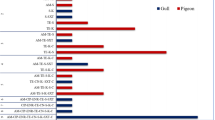Abstract
The aim of this study was to carry out a comparative molecular genetic characterization of Brucella isolates obtained from dogs and deer in Russia using current methods of typing. Isolates from dogs (n = 19) and deer (n = 2) were studied by PCR using primers to species and biovar specific Brucella differentiating gene target sequences and multiple locus variable number tandem repeats analysis (MLVA) with 12 pairs of primers to known variable loci of the Brucella genome. As a result of differentiating gene targets PCR identification, isolates from dogs were characterized as B. canis species, and those from deer as B. suis biovar 4. The MLVA molecular typing method of isolates revealed five identical and seven variable loci. A dendrogram constructed on the basis of MLVA-12 data combined all the isolates into a genetically related cluster together with reference strains B. canis RM6/66 and B. suis 1330, Tomsen, 686, 40 biovars 1–4. Seventeen MLVA genotypes have been revealed in isolates with a Hunter and Gaston discriminatory index (HGDI) = 0.9842. Molecular genetic characterization of B. canis and B. suis Russian isolates geographically distant from each other confirm the existing data that there is a close genetic relation between these two Brucella species. In addition, using the MLVA approach, the genetic diversity of these isolates and the association of closely related genotypes with a geographical region of primary isolation have been shown. In order to improve the system of epidemiological control of brucellosis in Russia, it is necessary to perform MLVA typing of isolates obtained from dogs and deer, which pose an epidemiological threat for human health.
Similar content being viewed by others
References
Vershilova, P.A., Brutsellez (Brucellosis), Moscow: Meditsina, 1972.
Zheludkov, M.M., Brucellosis in Russia: Modern Epidemiology and Laboratory Diagnostics, Extended Abstract of Doctoral (Med.) Dissertation, Moscow, 2009.
Zheludkov, M.M., Tsirel’son, L.E., Kulakov, Yu.K., et al., Epidemiol. Vaktsinoprofilakt., 2009, no. 6, pp. 23–28.
Kalinovskii, A.I., Brucellosis in Eastern Siberia and in the Far East, Extended Abstract of Doctoral (Med.) Dissertation, Irkutsk, 2006.
Kulakov, Yu.K., Zheludkov, M.M., Dranovskaya, E.A., et al., Mol. Genet., 1997, no. 3, pp. 15–17.
Kulakov, Yu.K., Zheludkov, M.M., Tolmacheva, T.A., et al., Mol. Genet., 2000, no. 4, pp. 7–12.
Kulakov, Yu.K., Erdenebaatar, J., Tsirel’son, L.E., et al., Zh. Mikrobiol. Epidemiol. Immunobiol., 2010, no. 3, pp. 17–22.
Kulakov, Yu.K., Erdenebaatar, J., Zheludkov, M.M., et al., Mol. Genet., 2011, no. 2, pp. 8–12.
Zhumilov, K.V., Kalmukov, V.V., Michailova, Y.P., et al., Veterinary, 1996, no. 5, pp. 55–59.
Al Dahouk, S., Le Fleche, P., Nockler, K., et al., J. Microbiol. Methods, 2007, vol 69, pp. 137–145.
Alton, G.G., Jones, L.M., Angus, R.D. et al., Techniques for the brucellosis laboratory, Paris. 1988, pp. 54–58.
Bikandi, J., San Millan, R., Rementeria, A., et al., Bioinformatics, 2004, vol 20, pp. 798–799.
Boom, R., Sol, C.J., Salimans, M.M., et al., J. Clin. Microbiol., 1990, vol. 28, pp. 495–503.
Bricker, B.J., Ewalt, D.R., Bio. Med. Central Microbiol., 2005, vol. 5. pp. 37.
Forbes, L.B., Can. Vet. J., 1991, vol. 32, no. 11, pp. 686–688.
Halling, S.M., Peterson-Burch, B.D., Bricker, B.J., et al., J. Bacteriol., 2005, vol. 187, pp. 2715–2726.
Her, M., Kang, S.I., Kim, J.W., et al., J. Microbiol. Biotechnol., 2010, vol. 20, pp. 1750–1755.
Hunter, P.R., Gaston, M.A., J. Clin. Microbiol., 1988. vol. 26, pp. 2465–2466.
Jiang, H., Mao, L.L., Zhao, H.Y., et al., Vet. Microbiol., 2012, vol.154, nos. 3–4, pp. 419–421.
Jiang, H., Mao, L.L., Zhao, H.Y., et al., Trans. R. Soc. Trop. Med. Hyg., 2010, vol.104, no. 12, pp. 796–800.
Kang, S.I., Heo, E.J., Cho, D., et al., J. Vet. Med. Sci., 2011, vol.73, no. 6, pp. 779–786.
Kulakov, Y.K., Zheludkov, M.M., Sclyarov, O.D., Vaccine, 2010, vol. 28,Suppl. 5, pp. 41–45.
Le Fleche, P., Jacques, I., Grayon, M., et al., Bio. Med. Central Microbiol., 2006, vol. 6, pp. 9.
Maquart, M., Le Fleche, P., Foster, G., et. al., Bio. Med. Central Microbiol., 2009, vol. 20, no. 9, pp. 145.
Microorganisms Tandem Repeats Database, http://minisatellites.u-psud.fr
Nockler, K., Maves, R., Cepeda, D., et al., J. Clin. Microbiol., 2009, vol. 47, no. 10, pp. 3147–3155.
Nomura, A., Imaoka, K., Imanishi, H., et al., Emerg. Infect. Dis., 2010, vol. 16, no. 7, pp. 1183–1185.
Rees, R.K., Graves, M., Caton, N., et al., J. Microbiol. Methods, 2009, vol. 78, no. 1, pp. 66–70.
Sayan, M., Erdenlig, S., Stack, J., et al., Jpn. J. Infect. Dis., 2011, vol. 64, no. 6, pp. 516–519.
Strom Holst, B., Lofqvist, K., Ernholm, L., et al., Acta Vet. Scand., 2012, vol. 27, no. 54(1), pp. 18.
Tiller, R.V., De, B.K., Boshra, M., et al., J. Clin. Microbiol., 2009, vol.47, no. 7, pp. 2226–2231.
Valdezate, S., Navarro, A., Villalon, P., et al., J. Clin. Microbiol., 2010, vol. 48, no. 8, pp. 2734–2740.
Wattam, A.R., Williams, K.P., Snyder, E.E., et al., J. Bacteriol., 2009, vol.191, pp. 3569–3579.
Whatmore, A.M., Shankster, S.J., Perrett, L.L., et al., J. Clin. Microbiol., 2006, vol. 44, pp. 1982–1993.
Zheludkov, M.M., Tsirelson, L.E., Biol. Bulletin., 2010, vol. 37, no. 7, pp. 709–715.
Author information
Authors and Affiliations
Corresponding author
Additional information
Original Russian Text © Yu.K. Kulakov, L.E. Tsirel’son, M.M. Zheludkov, 2012, published in Molekulyarnaya Genetika, Mikrobiologiya i Virusologiya, 2012, No. 4, pp. 28–32.
About this article
Cite this article
Kulakov, Y.K., Tsirel’son, L.E. & Zheludkov, M.M. Molecular genetic characterization of canine and rangiferine Brucella isolates from different regions of Russia. Mol. Genet. Microbiol. Virol. 27, 167–173 (2012). https://doi.org/10.3103/S0891416812040052
Published:
Issue Date:
DOI: https://doi.org/10.3103/S0891416812040052




